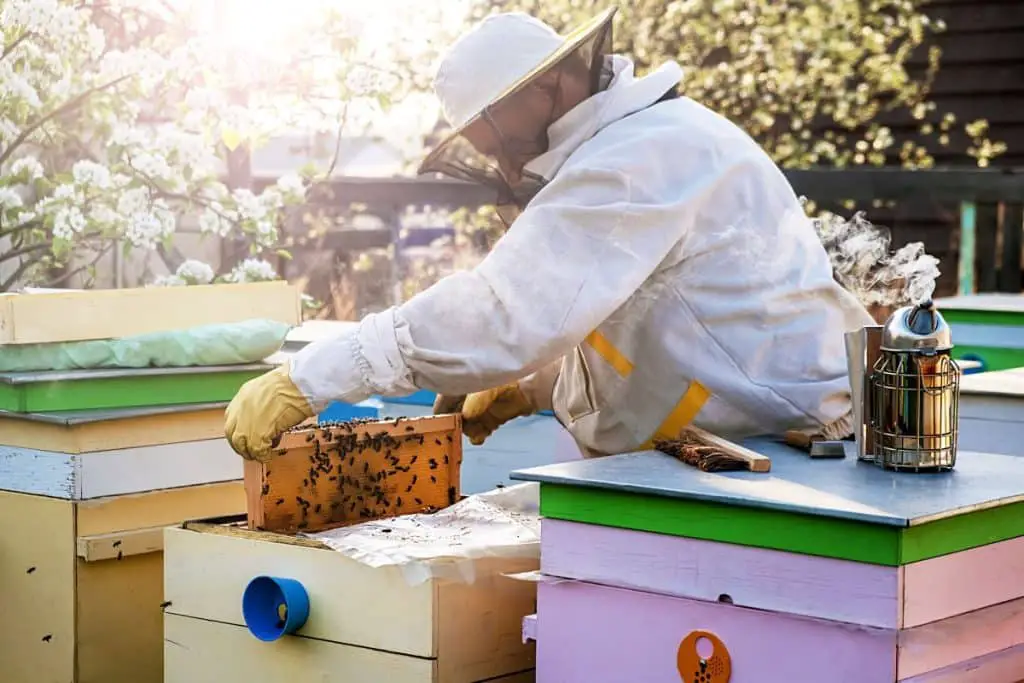There are many possible reasons why you want to start beekeeping – it could be for the income, its environmental benefits, or simply the fun of it. Regardless, it takes effort and time to be really good at it.
Backyard beekeeping for beginners starts with research. You have to learn the bee basics, local beekeeping laws and limits, and how to start for a more successful outcome
In this article, we’ll help you get started on your beekeeping adventure in just a few easy steps. Let’s get right into it!
Quick Navigation
- What Beginner Beekeepers Should Know About Bee Colonies
- What Are The Rules for Backyard Beekeeping?
- What Beekeeping Equipment Do I Need?
- How to Set Up Your Own Bee Colony
- The queen is responsible for laying eggs
What Beginner Beekeepers Should Know About Bee Colonies
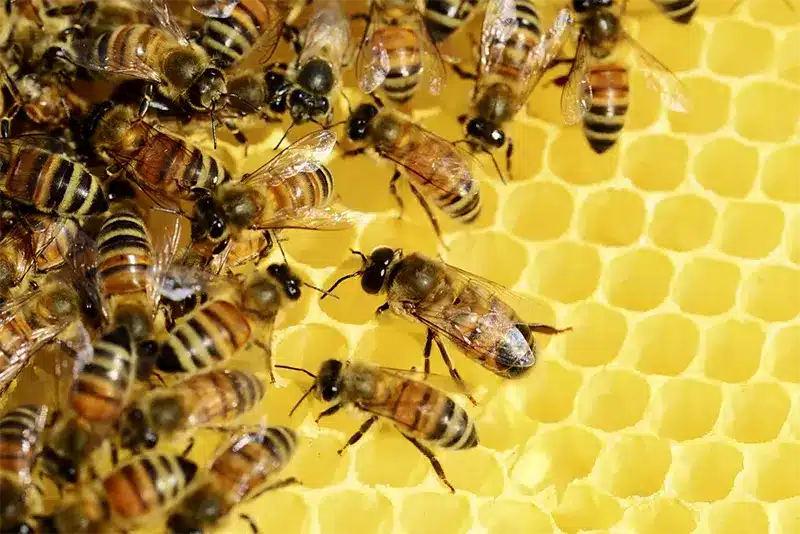
Before you actually set foot into the beekeeping industry, you have to get well-rounded on bee biology –from the way bees work around the hive to how they make and store honey. You can do self-study or enroll in beekeeping classes if you can!
In one honey bee colony, there are around 30,000 to 50,000 bees. Among those, there are worker bees, drones, and one queen bee. Each type of bee has its own role in the colony.
The queen is responsible for laying eggs, the worker bees manage the hive, and the drones mate with other queen bees from different colonies. Drones are indicators of a healthy hive, so ideally, your hive should consist of around 15% drones.
How Much Honey Can One Hive Produce?
If you want to start beekeeping because of your love for fresh honey, good news is that a single hive can produce 25 to 60 pounds of honey depending on how healthy the hive is. To harvest honey from the comb, beekeepers use a spinner machine.
Causes of Colony Deaths
Since 1990, there has been a significant decline in honey bee colonies. Despite the numbers recuperating steadily, there’s no guarantee that it won’t happen, especially for beginners who had no idea.
To avoid this happening to your own colony in the future, let us introduce you to the three main causes of colony deaths:
Parasitism
Varroa mites are the bees’ archnemesis. They lay eggs in hives and suck the lives out of adult bees causing the hive to die. Just like bees, they reproduce in colonies. As soon as your hives get infiltrated by these mites, it’s game over.
Colony Collapse Disorder (CCD)
20 years ago, beekeepers reported a strange phenomenon that caused the death of 30 to 90% of their hives. This phenomenon is called Colony Collapse Disorder (CCD) where worker bees suddenly leave their hive, their queen, and its young.
The main cause remains unknown. However, several researchers have presented theories about these including:
- Diseases and parasites (e.g Israeli Acute Paralysis, Nosema)
- Pesticide poisoning
- Stress
- Habitat changes
- Poor forage and nutrition
Pesticides
Pesticide affects the mental and physical health of bees. Mentally, it deteriorates their memory and learning capacity, making them unable to find pollen, water, and shelter which eventually leads to death. For the queens, high exposure to pesticides affects reproduction which results in fewer offspring.
What Are The Rules for Backyard Beekeeping?
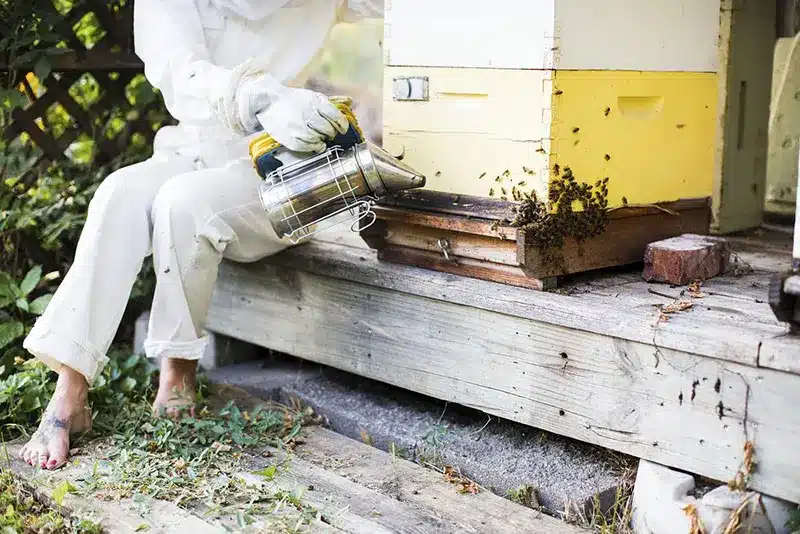
A new beekeeper should get acquainted with their residential area’s backyard beekeeping laws and regulations. A simple search on the internet usually does the trick.
But if not, you can try reaching out to your local beekeeping association or other experienced beekeepers. Find out what the local law says about the following:
- Are you allowed to keep bees?
- How many hives can you own?
- How far should your hives be from the property line?
Although you’ll have to do the initial research yourself, we can tell you one thing for sure – you ALWAYS need permission to start. Getting permission from local government officials and from neighbors should be prioritized to avoid any conflict that could lead to legal issues later on.
Establishing a good relationship with your neighbors right from the start will make it easier for you to start keeping bees. Additionally, this allows for easier communication altogether.
Nonetheless, fellow local beekeepers will tell you that you always have to be vigilant. If your neighbors express some issues concerning your bees, you have to address it ASAP.
It’s also important to educate your neighbors and correct any misconceptions they might have about bees. Here are a few facts that you can tell them as starters:
- Backyard beekeeping does not increase the number of bees in their neighbor’s area.
- Bees fly up to 3 miles away and will not visit their yards if there aren’t any flower-bearing plants around.
- Flowers don’t have unlimited nectar and pollen. As soon as the bees have emptied each flower, then they will travel away.
- Honeybees are gentle insects and will not use their stinger unless stepped on or swatted. After using it, the bee will eventually die.
It will also be helpful to let your neighbors know the difference between honey bees and wasps. This way, your honey bees won’t be blamed for some people getting stung out of nowhere. For instance, you can tell them that honey bees have hook-shaped stingers, while wasps have syringe-like stingers.
Do You Need A License to Start Backyard Beekeeping?
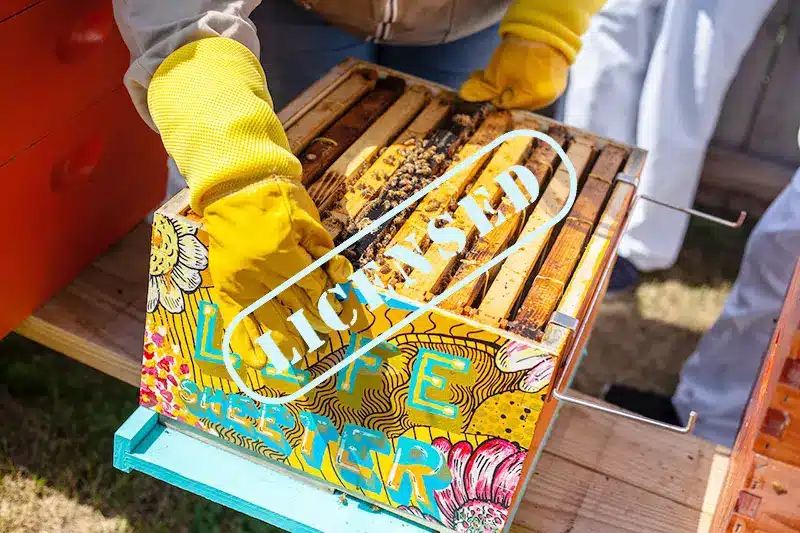
Most, if not all states, encourage you to register your hives. However, this requirement differs from one state to another.
For instance, in California, the County Agricultural Commissioner does not require beekeepers to register unless they own ten hives or more. In Australia however, all beekeepers are required to register their hives even if they only own one.
The reason behind this is because this allows for easier navigation in the case of exotic disease outbreaks and the like.
Post-registration, you have to make sure to display your registration number on every brood nest or hive entrance. Some areas conduct sudden hive inspections, so better be ready!
How Much Land Do You Need?
A standard beehive is around 22 by 16 inches, and per hive should have at least five feet of surrounding space for the best results. For multiple hives, every hive should be at least 3 feet away from the next.
Also, your hives should be at least 25 feet away from your home entrance, ideally. This is usually for better comfort for both the bees and your family. However, if your family is comfortable with it, then you can have it closer!
What Beekeeping Equipment Do I Need?
At this point, you’re already equipped with prerequisite knowledge to get the bee party started. So without further ado, let’s walk you through the essential beekeeping equipment you’ll need as a new beekeeper.
Hive
Start by getting yourself a wooden brood box or hive of your preferred size. You can buy one from local suppliers and online shops like Amazon, or create your own out of pine wood.
Other beekeepers suggest getting a hive enough for two colonies for starters. Having two colonies will help you know what works and what doesn’t and just gives you a better sense of proper beekeeping practices.
Protective Gear
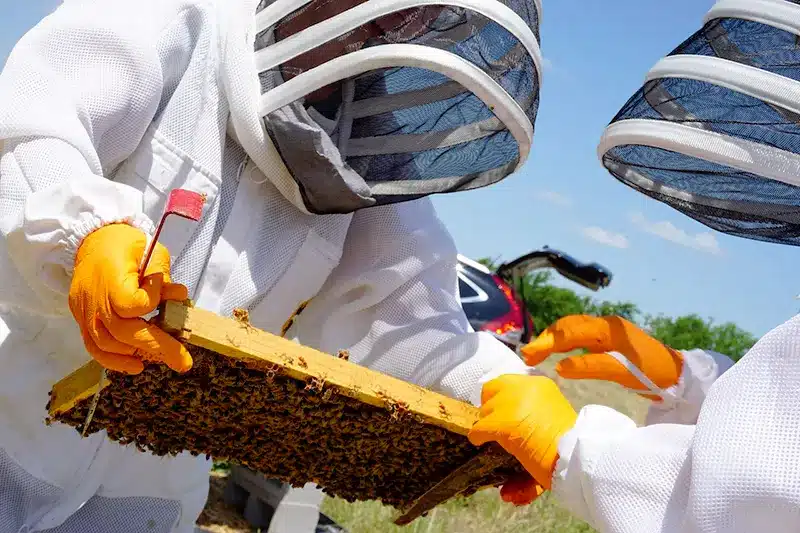
Constantly getting stung will discourage you from continuing the new hobby altogether. Hence, make sure you are fully equipped with protective gear including a veil and gloves. The more mesh material, the more breathable it is. Also, never use pre-loved gear to avoid the risk of contamination.
Hive Tool
To make hive maintenance a breeze, get yourself a hive tool. A crowbar helps you lift out your hive frames and scrapes off excess wax. Alternatively, you can also use an elongated paint scraper.
Smoker
A smoker is also valuable beekeeping equipment if you want to minimize the chances of getting stung. With one, you can keep the bees calm while harvesting honey or during hive upkeep.
Bees
Now that you have everything else, then it’s time to start obtaining bees! You can buy these from local bee suppliers or beekeeping associations and there are two ways to get your bees – as a package, or as a nucleus colony.
In a package hive, you get workers, a queen, and a sugar syrup feeder. The queen comes in a special cage, and the supplier usually teaches buyers how to properly introduce the queen to the other bees.
You can get a package of new bees for as low at $120 to as high as $295. This usually depends on the type of bees you get.
On the other hand, a nucleus colony is a half-sized colony. It includes five frames of comb, honey, bees, a queen, and baby bees (brood). A nucleus colony is better if you want to witness colony growth. However, it poses higher risk of pests and diseases.
How to Set Up Your Own Bee Colony
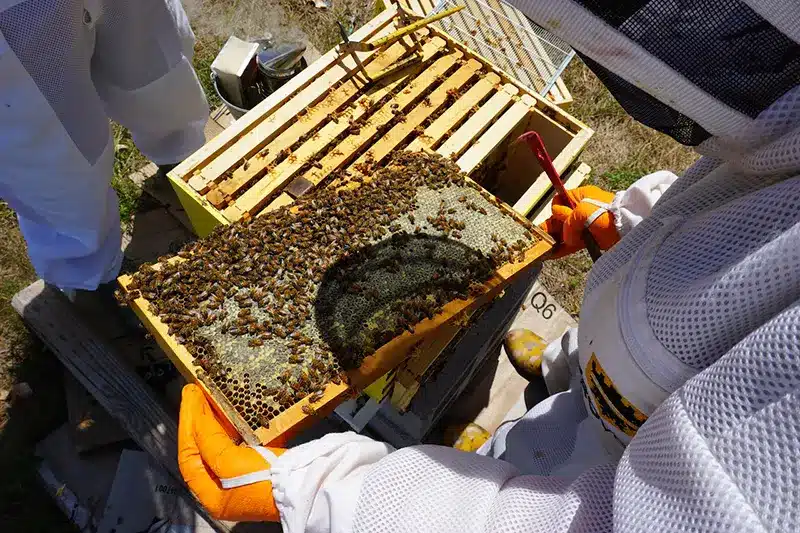
Now that you have everything you need, then it’s time to set up your own hive. To make it easier for you, we’ve prepared a simple step-by-step guide you can follow to start. Don’t forget to wear protective gear beforehand!
1. Choose the best time and location
There are five things to consider when picking the best area for your new colony – sunlight, fresh water, safety, local laws, and neighbors.
First, exposure to morning sunlight is important to keep pests away from your hive. So, try to pick an area where the bees can bask in the sun’s warmth and at the same time keep shade during the summer.
Springtime is the best time for backyard beekeeping! Second, set up a mini water station for your bees. You can use a plant saucer, or a water fountain.
Third, keep your hives away from high-traffic areas like playgrounds to avoid safety issues. Lastly, talk to your neighbors about your plans and see what they think about them. Most neighbors just need a bit of reassurance that it won’t be harmful or a nuisance to their space!
2. Transfer bees into their new hive
After choosing a location, transfer your bees into their new hive. To do so, you have to first keep them calm by spraying them with sugar water. Then, remove a few frames from the hive and slowly add in the bees.
Shake the box lightly and give them time to maneuver over their new home. After all the bees have been transferred, place the other frames back in.
Be careful! You don’t want to end up crushing some bees and get stung.
3. Add the Queen
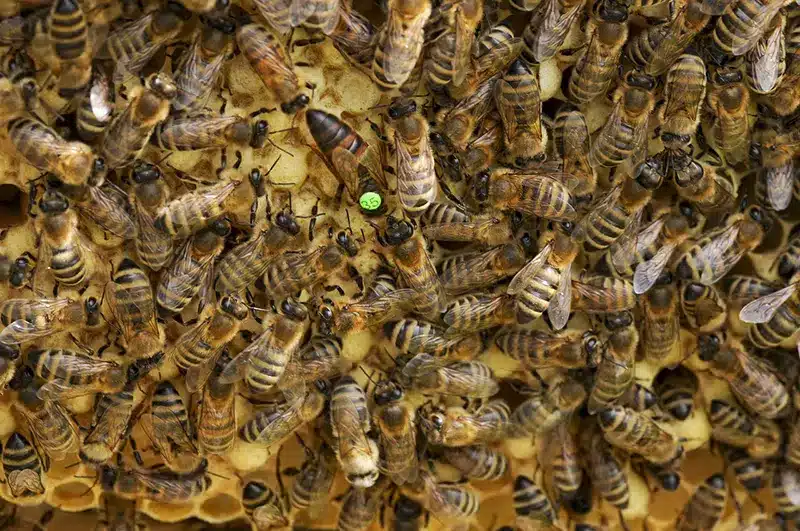
Next, hang the queen’s cage between two cages in the box. The queen comes in a separate cage with the other end enclosed by something sweet like marshmallows, which the other bees will eat until they release her.
During this time, they will be exposed to its pheromones and will decide whether or not they accept her as the hive’s new queen.
You might be interested in exploring the fascinating realm of increasing female pheromones for humans.
4. Feed your bees
It will take a few days until your bees fully set up their new hive. Hence, you have to keep your bees well-fed with a 2:1 sugar and water solution. Place the solution in a jar and set it on top of the brood box.
The jar should be placed upside down and the lid should have tiny holes so the bees can feed from the solution.
Do this until your bees can depend on the surrounding nectar flow instead.
5. Monitor your bees
After this, you can now leave your hives alone and stick to your preferred monitoring routine. Many beekeepers recommend novices to inspect once a week for starters, but once you get used to it, you can leave it alone for up to two weeks or more.
The less frequent the better, since smokers can stress out the bees and it will take around a day for them to recover.
Here are the things you have to do to keep your hive healthy:
- Clean the outside walls of your hive
- Clean the landing board
- Make sure there are no ants in your hive
- During hot days, check for eggs and larvae. The more larvae and eggs, the healthier the queen.
- Inspect hives for pests like hive beetles, wax moths, and most especially, varroa mites.
The queen is responsible for laying eggs
To sum it up, beekeeping is a high-investment hobby with a high return both profit-wise and environment-wise. To start, a good beekeeper will keep themselves well-rounded on bee basics and local rules and will keep a good relationship with their neighbors.
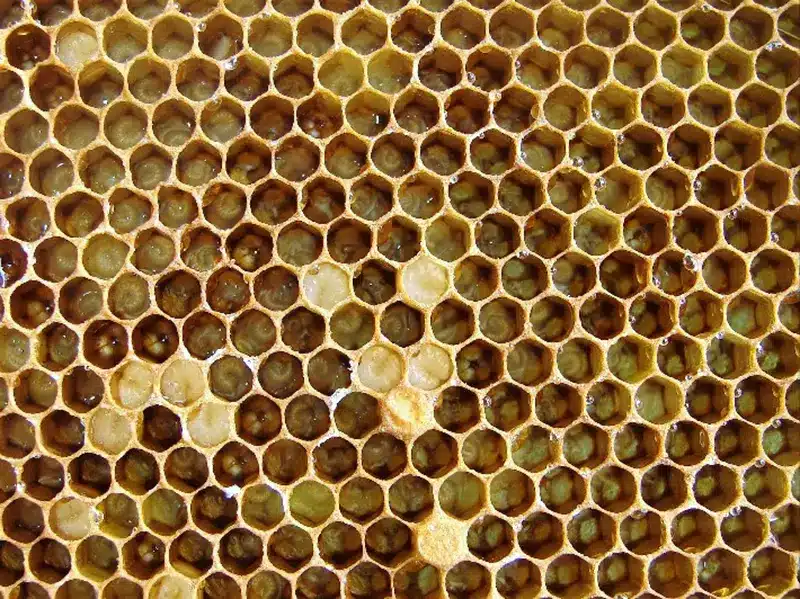
Doing so will ensure a better beekeeping experience and fewer risks of causing inconvenience for others.
There are five simple steps to set up your new hive. First, choose a location where your bees can enjoy sunlight, water, and privacy. Then, transfer your bees into their new home and keep them well-fed during their adjustment period.
After ensuring that they can now depend on the surrounding nectar, you can now let them ‘bee’.
Just don’t forget to check for any hive threats every now and then!

